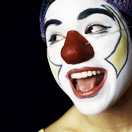
Circus
This project aims to develop students’ understanding of  mime. At the end of the project, in groups of three or four, they perform a circus to the rest of the class, in mime. Each student plays a different character in the circus.
mime. At the end of the project, in groups of three or four, they perform a circus to the rest of the class, in mime. Each student plays a different character in the circus.
The aims are to:
- understand how meaning can be communicated without dialogue, through movement and mime
- know and understand the conventions of mime and apply these in performance
- find and use information on the origins of the circus.
By the end of this project, students are expected to:
- have gained knowledge of mime and circus
- be able to perform in front of the class using mime
- be able to evaluate their work and that of others
- be able to listen to other people’s views and use the information to develop their own work
- be able to work in a variety of groupings.
The skills covered in this project include (but are not limited to)  mime and
mime and  still image.
still image.
The techniques which are covered in lessons in this project are:
- freeze frame
- improvisation
- mime.
The key words which are used in this project include:
- circus
- mime.
The text which students encounter during this project includes a description of a restaurant scene, images of the circus, films about the circus, scenarios for different characters in the circus, masks, circus music and spotlights, and any information they come across during their research.
This series of lessons has cross-curricular links with History and PE.
Students should be assessed in this project on the extent to which they:
- understand the technique of miming
- create a mask successfully
- portray a character and perform their role successfully
- evaluate their own work and that of others.
Web sites which could be used for further information on this topic include:
 | The World of Mime Theatre |
|---|
 | The Circus Space |
|---|
 | Circus Web! Circus Past and Present |
|---|
 | Circus World |
|---|
 | Sounds of the Circus |
|---|
This project meets the following recommendations from Drama in Schools (Second Edition) (Arts Council England, 2003). For a complete mapping, see Managing: Drama in Schools.
Level 3: Making
- Select appropriate lighting or simple symbolic props, sets or costumes, and understand their effect
Level 3: Responding
- Understand how meaning can be shown through the simple use of symbol, metaphor or imagery, eg using height and distance to indicate status and relationships
Level 4: Making
- Plan and structure plays that make use of a range of techniques and forms to express their ideas, eg narration in story theatre, mask work, and mime in physical theatre
A printable version of the project is provided here:
A summary of the project is provided here:








 Aims
Aims Circus
Circus